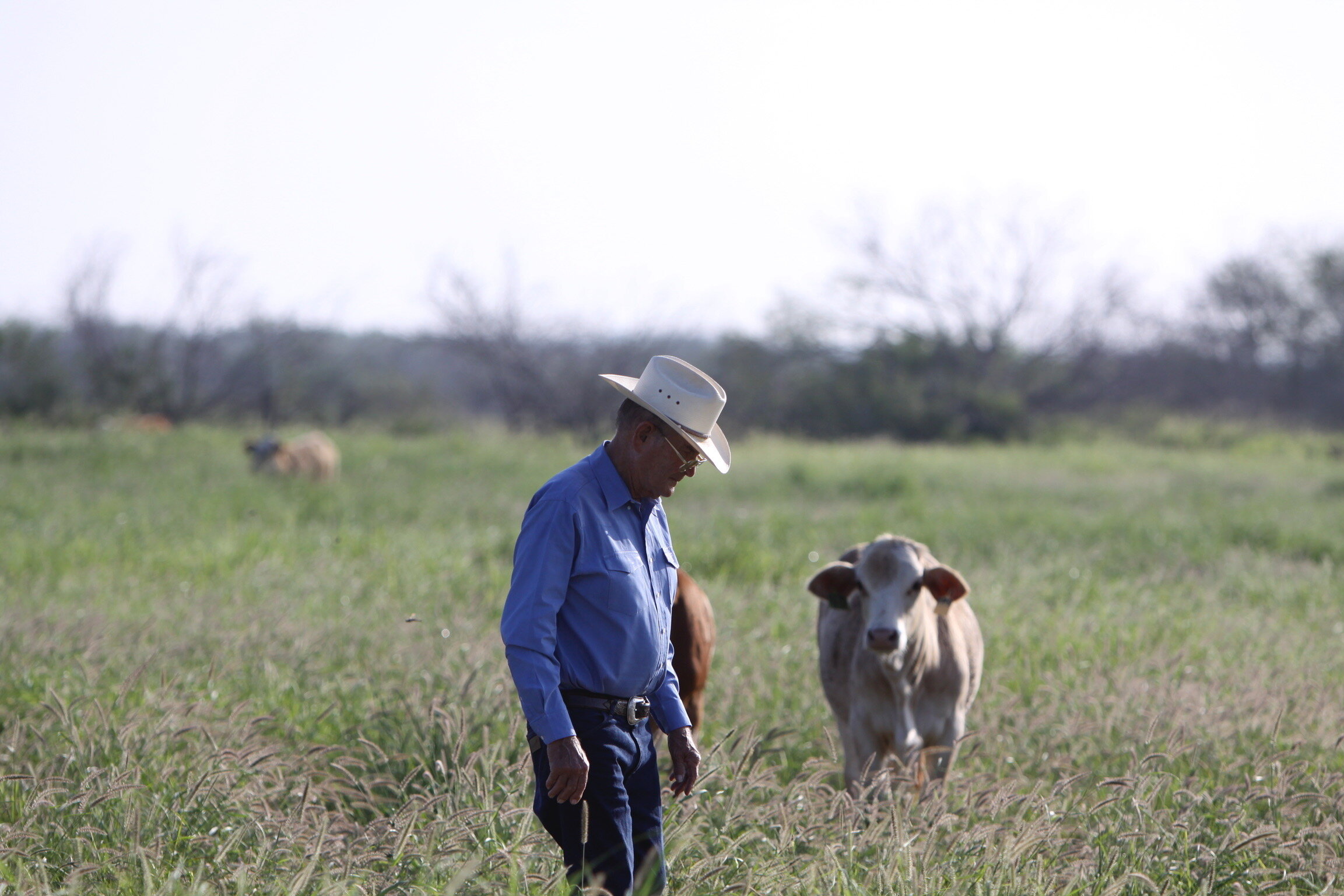Picture it: 1998, A young, food lover is asked to write an ode to something in her second-grade class. She chooses something very close to her meat-loving heart as her subject matter and the following poem is written:
Steak, steak, steak,
Yummy steak, hot steak,
Brown, grilled, great, steak,
Last of all, best of all,
Tasty Steak.
It probably comes as no surprise that, that young girl was me. My love of meat runs deep. If you have read my “hi, y’all” page then you know that my mother’s side of the family runs a ranch and cattle feedyard in South Texas. My grandfather started in the custom cattle feeding business in the mid-70’s and still runs it to this day, along with my uncle and his son, my cousin. Always agriculturally-inclined, prior to cattle feeding, he was a farmer with his father and brother. They still farm to this day, but most of the corn crop goes to feeding the cattle and they don’t measure their feeding needs in acres, but sections. So it is a rather large operation. My loyalty to my family’s business runs so deep that when I went for a routine check-up when I was no more than five or six, upon hearing of my “meat tooth,” my pediatrician made the recommendation that maybe I should not eat red meat five times a week. I quickly crossed my arms across my chest and told him very firmly and very loudly, “No!” Needless to say, I was not given the Walkman I so desperately wanted after the appointment to listen to my Space Jam soundtrack. And to this day I’ve never seen my mom so embarrassed (sorry, Mom!). Do I still eat red meat five times a week? No. But when I do indulge my meat tooth (What? Some people have a sweet tooth) I am a go big or go home girl. Give me a nicely marbled cut of meat, preferably a ribeye, cooked to a nice dark pink, an arugula salad, with a glass of Pinot Noir. Heaven.
Let’s take a quick dive into some of the most popular cuts of meat that you have probably seen on a menu and at the grocery store, and their best cooking methods for optimum flavor and texture.
The Ribeye, also known as the Tomahawk or Delmonico. See also: my favorite cut. Very nicely marbled, generally speaking depending on the grade out of choice, select, or prime, which could be another post all to itself. (Marbling is the white lines of fat running through the meat.) The ribeye comes off the top of the steer’s back, in the rib area, meaning this muscle is rarely used in its movement, and therefore going to be very tender and very flavorful due to the high level of fat in the muscle. Due to that high level of fat this cut of meat can get away with being cooked past medium and will not turn into a gray, chew toy. Also due to the higher fat content, this cut takes well to grills and cast iron, and cooking in direct, high heat. But if you have the time, reverse searing is a total game changer because you cook it initially low and slow, keeping as many juices in the meat as possible, and then sealing them in with a quick sear to create a crust.
The Filet Mignon, this is a very lean, tender cut that comes off the smaller part of the tenderloin of the steer. You will find it in the back-top half of the cow’s body, right under the sirloin. This cut takes best to a low and slow cooking technique, as with very little fat, can come very little flavor, if not prepared and cooked correctly. It also over cooks very easily, so I find that sous viding or reverse searing is your best bet, so you can more easily control the heat. Good for someone with a meat tooth that is watching their cholesterol.
The New York Strip, also called the Kansas City Steak or the sirloin, this cut is known as the “goldilocks” of steaks because can help please a crowd and is a little more wallet friendly, making it “just right.” The Strip comes from just behind the rib area of the steer, from the short loin. While it is not as lean or tender as the filet, it is much leaner than the ribeye, and can still deliver a rich, meaty flavor. Since it is on the leaner side, like its filet friend, it can be overcooked more easily. Sticking with a more precise cooking method, a sous vide or reverse searing is going help the New York Strip step out of the shadows of its meat counterparts. Cook rare to medium for best results. It would take well to a wood-fired grill with a precise temperature gauge to help infuse flavor via smoke.
The Porterhouse, also known by its stage name the T-Bone. The porterhouse is nothing more than the marriage of two steaks: the filet and the New York Strip, separated by a T-shaped bone. Neighbors with the Strip, this cut comes from behind the short loin, from the sirloin part of the steer. While a bone in a piece of meat generally means a more flavor, this is cut that needs to be a little more babysat in order to help that flavor come out. Meaning put any flat surfaced cooking device away. Due to the presence of the bone, the steak will not sit flatly in a pan; therefore, one side could overcook, and we already discussed how the filet is already prone to do that. Best to fire up the grill or broil in order to achieve an evenly cooked steak.
You probably noticed that I referenced the reverse sear cooking method multiple times above and are wondering what on Earth is this magical method you keep referencing, Savannah? Fear not. I am about to talk you through it and give you my recipe. Reverse searing is nothing more than reversing the typical cooking process of a steak. So instead of using heat to cook the steak from the outside-in, you cook the steak from the inside-out. By doing this you get more control over the internal temperature of the steak by using the oven. Then once your steak has reached your desired temperature, you place your steak in a ripping-hot skillet, and allow it to develop a crust with butter, garlic, and if you’re feeling fancy, thyme. Let’s talk through my recipe and method.
Ingredients/Materials:
8 oz ribeye (or really any cut/size of steak you want)
Kosher salt, measurement will vary due size of meat
Fresh-cracked pepper,measurement will vary due size of meat
3 tablespoons of a neutral, high smoke point oil (ex. canola or avocado) or 3 tablespoons of shortening
3 tablespoons of butter
3 smashed garlic cloves
2 sprigs of thyme (optional)
A thermometer
Foil
Sheet pan
Wire rack or cooling rack
paper towel
Method:
Take your steak out to come to room temperature for about 20-30 minutes prior to preparing it to be cooked. Using a sheet pan that is lined with foil, with a rack placed on top. Place steak on top of the rack and allow to come up to temperature. Once to room temperature, dry off excess moisture with a paper towel and liberally apply salt and pepper to all sides of the steak and leave to rest for 30 minutes.
While resting, preheat your oven to 250 degrees.
Once oven temperature is reached and steak finished resting, place steak into the oven. Cooking until it reaches your desired internal temperature: for rare 105 degrees, 115 for medium-rare, 125 for medium, I allow my steak to cook first 30 minutes and then check the internal temperature about every 5-10 minutes after depending how close it is to my desired temperature, then more frequently as it gets closer.
Once your steak is within a few degrees of your desired temperature, place your skillet on high heat with your choice of oil or shortening and heat until pan nearly smokes.
Take out steak immediately once desired internal temperature is reached.
Place steak into the skillet and allow crust to develop. If the steak has a fatty collar, like on a ribeye, place fatty side in the pan first to release more fat and flavor into the pan, then place on one of its sides. Reference the how to video for further clarification on this.
Sear steak for 60-90 seconds, or until deep crust has developed and flip.
Once flipped to the other side, place butter, garlic, and thyme into the pan.
Tilting the pan up so that butter pools, use a spoon to coat steak in butter, and rub with hot garlic and thyme.
Continuing to sear for 30 seconds and take immediately off heat.
Place on a carving board, spooning remaining butter, garlic and thyme over the top. Tuck in the whole endeavor in with foil, covering the steak completely, and rest for 10 minutes.
Serve immediately and enjoy the fruits of your labor. Here’s to celebrating your own meat tooth!
A quick how to video that I made last year. Note: this video does not include the butter basting technique I included in the recipe above.




The little girl who yelled at her doctor and her cattleman grandfather, along with some other pictures of the gentleman cowboy in the place he built from scratch, the feedyard…



